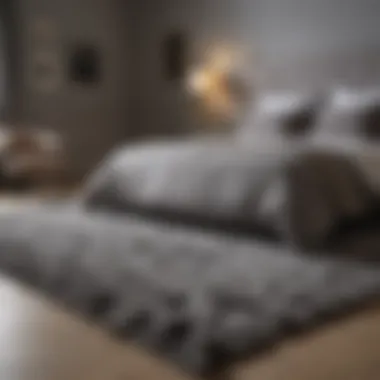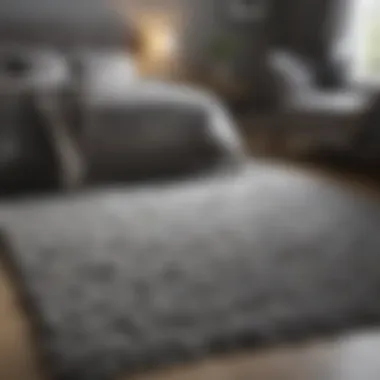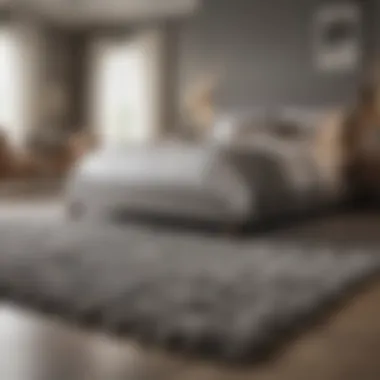Elevate Your Bedroom Design with a Grey Rug


Intro
When it comes to bedroom design, the choices we make can drastically influence the overall feel of the space. One often-overlooked yet impactful element is the rug. A grey rug, in particular, can serve multiple roles—being not only a decor staple but also a tool for enhancing comfort and visual appeal. It's like icing on the cake, you might say. This article dives into the intricate dynamics of grey rugs, exploring how they can elevate bedroom aesthetics, create harmony with other decor elements, and provide practical benefits that enhance daily life.
Trending Styles
When considering grey rugs, various styles align beautifully with contemporary design trends. Let's explore some options:
Modern Minimalism
Minimalism in the modern bedroom often centers around clean lines and uncluttered spaces. Grey rugs in this context can act as a canvas. Their subtle hues provide a gentle contrast against white or light-colored floors, allowing for an airy ambiance that feels both sophisticated and soothing. Choose a low-pile grey rug with a simple geometric pattern—this can tie the room together without overwhelming it.
Cozy Rustic
On the other end of the spectrum lies the cozy rustic approach. Imagine a cabin retreat, warm wood accents, and an inviting atmosphere. A thicker, shaggy grey rug can infuse warmth and texture, making the space feel inviting. Such rugs work well with wooden beams and stone elements, providing a soft landing for your feet while visually balancing the natural materials surrounding them.
Color Palettes
Color is crucial in setting the mood and style of a bedroom. When integrating a grey rug, think about how it interacts with other hues in your space. Here are two effective palettes to consider:
Calming Neutrals
Pairing a grey rug with other neutral tones like beige, taupe, or soft whites can create an oasis of calm. This palette lends itself to a serene atmosphere that’s perfect for unwinding after a long day. It feels balanced and soothing—a true sanctuary to escape the hustle and bustle. A combination of different textures in cushions and linens enhances the snug feel.
Bold Accents
Alternatively, a grey rug can act as a grounding element in rooms bursting with color. Consider bright yellows, deep blues, or wild greens as accents against the grey. This contrast can bring energy into the bedroom without causing chaos. A bold bedspread or eye-catching artwork can harmonize beautifully when balanced with a neutral grey underfoot.
"The right rug doesn't just add style; it shapes the very experience of your space."
Practical Benefits of Grey Rugs
Aside from aesthetics, there are practical considerations at play. Grey rugs are generally easier to maintain than lighter-colored options. Dust and stains are less likely to show, making them perfect for busy households. Moreover, their versatility allows them to fit in whether you’re aiming for a more traditional look or something avant-garde.
In summary, grey rugs present a unique opportunity to enhance your bedroom design through a mix of style, color palettes, and practical advantages. They serve not only as decor pieces but also as facilitators of comfort and tranquility.
Prolusion to Bedroom Decor
When it comes to bedroom design, achieving an inviting and harmonious space is not just about slapping down furniture and calling it a day. The introduction to bedroom decor gives a solid groundwork on how elements such as color, texture, lighting, and furnishings intertwine to create a space that reflects personal style while remaining functional. A well-decorated bedroom stands as a sanctuary where one unwinds, gathers thoughts, and rejuvenates after a long day.
In this context, every detail matters. Spaces lacking a cohesive design may feel chaotic and disorganized. An integrated look can elevate a room, fostering feelings of tranquility and warmth. Ultimately, a well-planned bedroom showcases your individual tastes and provides comfort and ease within the flow of daily routines.
Importance of a Cohesive Design
A cohesive design isn’t merely about choosing matching shades of paint or stylish furniture. It encapsulates a broader approach, emphasizing the importance of blending various pieces into a unified aesthetic. Picture a puzzle, each piece representing a different aspect of the room's atmosphere. When fitted together thoughtfully, they create a vision complete with flow and balance.
In the context of incorporating a grey rug, a cohesive design enables it to act as more than just an underfoot element. It can become a powerful focal point or a soothing backdrop depending on your choice of surrounding colors and textures. The rug’s hue serves as a middle ground, making it easier to mix and match various textiles and colors without clashing. This unity not only provides visual pleasure but also enhances the room’s overall ambiance.
The Role of Textiles in a Bedroom
Textiles hold a pivotal role in bedroom design, often serving as the unsung heroes of comfort and style. The various fabrics used—be it curtains, linens, or rugs—work together to set the mood of the space. In many ways, textiles adjust the tactile experience of a room, inviting cozy feelings during colder seasons or evoking a cool breeze when summer rolls around.
A grey rug, specifically, can dramatically transform this tactile landscape. The soft texture beneath one’s feet brings an immediate sense of warmth, while its neutral tone allows for additional layers, patterns, and colors to flourish without overwhelming the senses. Whether it’s the juxtaposition of a bold throw pillow or the delicate draping of bed linen atop a quilt, the right textiles harmonize to create a lush bedroom tapestry. You may even notice that rugs cushion sounds, reducing echo and fostering a peaceful atmosphere.
"In the intricate ballet of bedroom decor, textiles become the dancers, each step contributing to the story a room tells."
By recognizing the role that textiles play, particularly through the lens of a grey rug, homeowners can thoughtfully curate their personal haven, crafting a space that marries aesthetics with ease.
Understanding Grey Rugs
When designing a bedroom, grey rugs play a pivotal role that often goes unnoticed. They serve not just as floor coverings but as essential elements that bring the entire look of a room together. Understanding grey rugs encompasses various dimensions, from their types and materials to their aesthetic and practical benefits.
Types of Grey Rugs
Area Rugs
Area rugs are significant in any bedroom. They come in various sizes and typically cover a substantial portion of the floor space. One distinct aspect of area rugs is their capacity to anchor furniture pieces, thus defining a space and making it feel cohesive. It's a beneficial choice for bedrooms because it allows decor elements to coexist harmoniously. A unique feature of area rugs is the variety of designs available, from intricate patterns to minimalist looks, allowing you to tailor your choice to the rest of your room's decor. However, one disadvantage might be the size—you need to pick the right dimensions to avoid overwhelming the space.
Runner Rugs


Runner rugs shine in areas like narrow spaces or beside beds. Their long, rectangular shape provides a stylish way to add texture without dominating the room. A key characteristic of runner rugs is their functionality; they can delineate spaces while offering comfort underfoot. They serve as a bridge between various decor elements, enhancing flow within the bedroom. However, if not chosen carefully, they might not fit well into larger spaces, becoming lost in the expanse without a proper context.
Shag Rugs
Shag rugs bring a cozy touch to bedroom designs, known for their long fibers that offer softness and warmth. This type of rug is especially popular for establishing a welcoming atmosphere. Their key characteristic lies in their texture—stepping onto a shag rug feels plush and cushy, which is enticing after a long day. This tactile quality can significantly enhance the room's feel, making it more inviting. On the flip side, shag rugs may require more maintenance, as dirt can get trapped in their fibers, which necessitates regular cleaning to keep them looking pristine.
Materials Used in Grey Rugs
Wool
Wool rugs are a quintessential choice for many interior designers, thanks to their natural durability and warmth. One noteworthy aspect of wool is its ability to withstand wear without losing its charm. These rugs can handle heavy foot traffic well, making them an excellent investment for a bedroom that is frequently used. Moreover, wool offers natural insulation, keeping your space warm in winter. A unique feature is its ability to resist staining, but one must consider that they can be more expensive than synthetic options.
Polyester
Polyester rugs hold their ground as a popular choice among homeowners looking for something stylish and budget-friendly. The key characteristic of polyester is its vibrant color retention, which means your grey rug will not fade easily under sunlight. Additionally, they tend to be very soft to the touch, making for a comfortable experience underfoot. However, polyester can sometimes lack the durability that natural fibers offer, and they might show signs of wear faster in households with pets or children.
Nylon
Nylon is a fiber that has grown in popularity due to its resilience and stain resistance. One significant attribute of nylon rugs is their ability to bounce back from foot traffic, so flattening is less common in this material. It's also quite versatile, available in various textures and patterns, which makes it an appealing choice for decorating. However, it can also be prone to static electricity, which might not be ideal in certain settings.
In summary, understanding the breadth of choices—in terms of types and materials—when it comes to grey rugs can significantly influence not only the design aspects of your bedroom but also its functionality and comfort.
Aesthetic Benefits of Grey Rugs
In the intricate dance of bedroom design, grey rugs often act as the unsung heroes, deftly weaving together various elements of style and substance. They play a pivotal role in transforming a simple room into a sanctuary. When thinking about aesthetics, these rugs can offer much more than just a surface to step on. Understanding the aesthetic benefits can help homeowners make educated choices that harmonize with their desired ambience.
Neutral Palette and Versatility
Grey is often considered a neutral canvas, yet its shades range from soft dove to deep charcoal. This pallette versatility enables grey rugs to effortlessly blend into diverse design schemes. Whether the decor leans toward modern minimalism or classic elegance, a grey rug can tie the room together without stealing the limelight.
- Complementary Colors: The neutrality of grey makes it a fantastic companion for other hues. It can enhance bolder colors without overshadowing them. For example, a bright yellow or rich navy can pop against a grey background, elevating the overall aesthetic.
- Patterns and Textures: A grey rug can come in myriad patterns and textures, allowing it to fit snugly into any thematic decor. From intricate geometric designs to understated textures like shag or woven, the choices are endless, depending on personal taste and overall design goals.
- Seasonal Adaptability: As time marches on and seasons shift, grey rugs can accommodate changing decor themes. You could easily swap out brighter throw pillows or curtains as you transition from summer to fall, while the grey rug maintains a sense of continuity.
In summary, the versatility of grey rugs makes them a reliable choice for many decorating styles, acting like a chameleon within a space.
Creating a Calming Atmosphere
The bedroom should feel like a haven, a restful place to retreat from the chaos of everyday life. A grey rug's soothing tones contribute significantly to this atmosphere.
Grey, often associated with tranquility, can create a serene environment that promotes relaxation. The subtlety of its tone helps to soften the perceived harshness of a room's more vibrant colors. Here are some of the ways grey rugs help in achieving that calming vibe:
- Harmonious Blend: They can stabilize a room’s temperature visually and create a sense of balance. If a room is heavily accented with warmer hues, a grey rug can cool down the overall visual temperature.
- Layered Textures: Incorporating a grey rug can add depth to the design. Combining different textures, such as pairing a sleek grey shag rug with wooden furniture, can deepen the sensory experience. This layering helps the space feel rich and inviting.
- Restful Base: A grey rug underfoot creates a gentle touch, an immediate sense of comfort once you step onto it. That feeling, subtle as it might be, lends itself to a relaxing start or finish to your day.
"Incorporating a grey rug is not just about style, it’s about creating an emotional space where one can unwind and feel at home."
The influence of a grey rug should not be underestimated. When chosen thoughtfully, it can amplify the beauty and comfort of your bedroom, creating a retreat you will always look forward to coming back to.
Practical Considerations for Choosing a Grey Rug
When it comes to enhancing the bedroom with a grey rug, there’s more to it than just picking one that looks nice. Practical considerations are crucial. A rug isn’t just a decorative item; it serves functional purposes too. This element can tie a room together, add comfort underfoot, and can even provide warmth, especially in colder months.
Sizing and Scale
Selecting the right size for your rug can be a bit of a balancing act. Too small, and it might look like an afterthought; too big, and it can overwhelm the space and make it feel cramped. To get it just right, consider the measurements of your bed and other furniture.
- General Guidelines:
- For a king-sized bed, a rug measuring at least 9 feet by 12 feet is often recommended.
- A queen-sized bed usually pairs well with an 8 feet by 10 feet rug.
- For more compact spaces, a smaller area rug can be placed at the foot of the bed.
It’s helpful to visualize or even tape out the measurements on the floor to understand how different sizes will fit in the room.
"Choosing the right size can elevate the overall aesthetic, making the room feel cohesive and inviting."
Durability and Maintenance
A rug is an investment, and the durability of the material matters significantly over time. Grey rugs come in various materials, so consider where the rug will be placed and how much foot traffic it’ll face. Plush wool or durable nylon may be ideal for high-use areas. On the other hand, a more delicate polyester might work perfectly in a guest bedroom with less foot traffic.
Once you've selected your rug, maintenance must also be in your mind. Here are a few tips to keep it looking fresh:
- Regular Vacuuming:
This is essential to keep dust and dirt at bay. Depending on the material, a vacuum with beater bars may damage delicate fabrics, while a suction-only vacuum is softer on the fibers. - Spot Cleaning:
Accidents happen, and addressing spills quickly can save your rug. Blot up the liquid without rubbing, and use a mixture of mild soap and water to clean the area. - Professional Cleaning:
For deeper cleans, consider professional services to ensure the integrity of the rug is maintained over time.


In essence, considering sizing and durability ensures that a grey rug doesn’t just complement your home’s design but also withstands the realities of daily life.
Integration with Other Decor Elements
In the journey of crafting a harmonious bedroom space, integrating your grey rug with other decor elements is pivotal. Grey rugs can serve as a bridge connecting various design aspects, facilitating a seamless look that engages the eye while offering tranquility. Understanding how to coordinate colors, patterns, and furniture styles with your chosen rug can significantly enhance both aesthetics and function in your bedroom.
Coordinating Colors and Patterns
Color and pattern play an undeniable role in design cohesion. Grey, being a neutral shade, opens up numerous possibilities for coordination. When selecting colors to complement your grey rug, consider the overarching scheme of the room. Using a color wheel can help you identify complementary tones or shades that either harmonize or offer contrast.
- Soft pastels: Light pinks or gentle blues can lend a soothing atmosphere, especially when paired with brighter accents.
- Bold colors: A saturated royal blue or mustard yellow might create striking contrasts and visual interest, adding depth to your bedroom.
Patterns also need careful consideration. A striped or geometric patterned grey rug can serve as a focal point, easily coordinating with solid colored bedding or curtains. Conversely, if the rug is solid, layered patterned elements can enliven the decor. Balance is key; blend busy patterns with more muted tones to avoid overwhelming the space.
Pairing with Furniture Styles
Pairing your grey rug with the right furniture style is crucial in achieving a polished look. Each design style brings its own flavors and nuances, and understanding them can aid in selection.
Modern
Modern design is characterized by clean lines and simplicity. When incorporating a grey rug here, you’ll often find that it complements the minimalist aesthetics beautifully, acting almost as a canvas for sleek furniture pieces. A key characteristic of modern decor is its focus on functionality and form. This makes grey rugs a popular choice, as they don’t distract but rather ground the space.
- Unique feature: The lack of clutter in modern spaces enhances attention to detail, such as the texture or pattern of the rug itself.
- Advantages: This style maintains an airy feel, ensuring that the grey rug enhances without overpowering.
Traditional
Traditional design emphasizes classic elements and rich textures. A grey rug adds a contemporary twist to this timeless style, allowing for the preservation of warmth and elegance. Key features of traditional decor include vintage furnishings and ornate details, which the neutral tones of a grey rug can harmonize beautifully with.
- Unique feature: It provides a modern backdrop that allows antique furniture to shine.
- Advantages: This juxtaposition promotes a balanced aesthetic, offering a sense of sophistication while keeping things modern.
Eclectic
Eclectic design is all about mixing and matching various styles to create a personalized environment. In this context, a grey rug can act as a unifying element, binding together diverse furnishings and decor items. The key characteristic is the playful combination of textures, colors, and patterns.
- Unique feature: The versatility of grey allows it to adapt to whatever quirky elements you bring in.
- Advantages: It holds the room together, preventing the decor from appearing too fragmented, while adding an element of surprise.
Integrating your grey rug with other elements in your bedroom can transform not just the appearance but the feel of the space. When done right, it creates a sophisticated retreat where every piece tells a story.
Placement Tips for Grey Rugs
When it comes to designing a bedroom, the placement of a grey rug can significantly impact the overall ambiance and functionality of the space. The right positioning of the rug not only enhances the aesthetic value but also contributes to comfort, warmth, and even safety. Whether you’re creating a cozy nook or a stylish retreat, understanding how to properly place a rug can help you bring out the best in your interior design.
Under the Bed Vs. In the Center
One of the common dilemmas faced by homeowners is deciding whether to place a grey rug underneath the bed or in the center of the room. Each option presents distinct advantages depending on the layout and purpose of your bedroom.
- Under the Bed: Placing a rug under the bed is often a go-to choice for many. This design choice anchors the bed within the room's space. It creates a unified look that visually ties together the furniture, making the room feel more cohesive. Ideally, the rug should extend a bit beyond the edges of the bed, about 18 inches or so, giving a welcoming feel as your feet touch the soft fibers upon getting out of bed.
- In the Center: Alternatively, having a rug in the center of the room can lend a casual, inviting atmosphere. This option works well in larger spaces where the bed isn't the sole focal point. By positioning the rug centrally, you can create separate zones or areas within the bedroom, perhaps for reading or relaxing. It can also bring in texture and color that draws the eye, making the room feel alive.
A well-placed grey rug can transform the energy of a bedroom, making it either snug and intimate or open and airy.
Layering Rugs Effectively
Layering rugs can be a bold design statement that enhances the richness of your bedroom’s decor. This technique involves placing a smaller rug atop a larger one or combining rugs that differ in texture and design. Here are some effective tips to consider for layering:
- Mix Textures: Combine a plush grey shag rug with a flat-weave sisal or jute rug. This contrast not only adds depth but also encourages tactile interaction.
- Color Coordination: While grey is neutral, consider colors or patterns in the rugs that harmonize with other elements in the room. For example, a patterned rug can add an unexpected pop while complimenting solid grey.
- Balance Scale: If your base rug is large and bold, opt for a smaller, subtler top rug. Conversely, if the base is understated, a more elaborate design on top can create visual interest without overwhelming the space.
- Consider Orientation: When layering, pay attention to how the rugs align. A diagonal placement can break monotony and make the space more dynamic.
- Practicality: Ensure that the layered setup doesn’t cause tripping hazards, especially in high-traffic areas.
Layering rugs can lead to a stylish space where each layer plays a role in the narrative of the room. It invites creativity and gives you a chance to play with patterns, textures, and tones, ultimately enriching the overall design.
Maintenance Strategies for Longevity
Maintaining a grey rug in your bedroom goes beyond mere aesthetics; it ensures the longevity of your investment and helps keep your space looking fresh. A well-cared-for rug can serve as a foundation for your decor, while neglect can quickly turn what once was a stylish accent into an eyesore. To get the most out of your grey rug, one must understand the cleaning and maintenance routines tailored to its material and style.
Regular Cleaning Techniques
Cleaning your grey rug regularly is essential, not just for appearance but for hygiene too. Dust, dirt, and pet dander can accumulate, leading to a dull look and potential health issues.
- Vacuuming: This is your first line of defense. Depending on foot traffic, aim to vacuum at least once a week. Use a vacuum cleaner with a brush attachment, but avoid beater bars, which can damage delicate fibers.
- Spot Cleaning: Address spills promptly. For liquid spills, blot—not rub—using a clean cloth. This keeps the liquid from spreading further. For solid debris, use a spoon to gently lift it off, then clean the area with a gentle detergent solution.
- Deep Cleaning: Every six to twelve months, consider deep cleaning your rug. This could mean hiring a professional or renting a carpet cleaner depending on the rug's material. If the rug is machine washable, be sure to follow the manufacturer's instructions for care.
Handling Stains and Spills


We all know that accidents happen. Whether it’s a dropped glass of wine or a toddler’s art project gone awry, stains are inevitable. Quick action is key to minimal damage. Here’s a smart playbook for dealing with stains:
- For Food Spills: Scrape away any extra food with a dull knife, then tackle the stain with a mix of mild dish soap and water. Apply lightly using a cloth, and avoid soaking.
- For Pet Accidents: Act fast. Blot up the excess moisture, then clean with a mixture that neutralizes odors. Vinegar mixed with water can be quite effective.
- For Ink or Tough Stains: A paste made of baking soda and water can lift tougher increments. Let it sit for a bit, then vacuum.
Tip: Always test any cleaning solution on an inconspicuous area of the rug to avoid damage.
Being proactive about your rug’s maintenance not only prolongs its life but also keeps your bedroom looking neat and inviting. With the right strategies, your grey rug can continue to enhance your space for years to come.
Common Mistakes to Avoid
When it comes to designing a bedroom, there are several common pitfalls. Understanding these mistakes not only enhances your decor but can also make using a grey rug significantly more impactful. Without a doubt, a grey rug can elevate any space by adding depth and character. However, missteps in selection and placement can impede its effectiveness. This section will focus on two crucial mistakes: choosing the wrong size and neglecting the importance of texture and material. By carefully considering these elements, you can ensure your grey rug contributes positively to the overall ambiance of your bedroom.
Choosing the Wrong Size
The size of a rug can make or break its design potential. Opting for a grey rug that’s too small can create a disjointed look, leaving your room feeling fragmented, instead of cohesive. A little rug just sitting in the middle of the floor can feel a bit like a fish out of water. While a larger rug can unify your space, it also can function as a visual anchor, drawing all elements of the room together.
Think about how your rug will fit under your bed or around your furniture. Ideally, the front legs of your bed should rest on the rug, with enough space surrounding it for other furniture. This creates an illusion of greater space and adds warmth to your bedroom.
- Pro Tip: Measure your room and furniture before purchasing a rug.
- Common Size Guidelines:
- Large bedrooms: 8x10 feet for under the bed
- Medium bedrooms: 6x9 feet to anchor seating areas
- Small bedrooms: At least a 2x3 foot mat near the bed.
By choosing the right size, you'll enhance the fluidity and ambiance of your design layout, bringing forth a more inviting environment.
Ignoring Texture and Material
The mosaic of textures within a room is just as important as color and size. Many people overlook this aspect when selecting a grey rug. A grey rug made of a soft, inviting material can introduce much-needed comfort and warmth to your space. Conversely, a rug that feels scratchy or harsh can detract from the cozy atmosphere that you might be aiming for.
Consider various materials such as wool or cotton blends, which offer both durability and comfort. A wool rug, for instance, can resist stains, while adding a delightful plushiness underfoot. On the other hand, polyester options might be stain-resistant but lack the warmth and character of natural fibers.
- Key Considerations:
- Check how the texture complements existing decor
- Assess its warmth in the room – is it inviting?
Ignoring the texture and material may result in a disappointing experience. By thoughtfully selecting materials and textures that align with the rest of your decor, you enhance not only the aesthetic appeal but also the overall functionality of your space.
"You can't underestimate the role of texture; it infuses life into the design and helps to narrate your personal story."
In summary, avoiding these common mistakes—selecting the wrong rug size and overlooking material and texture—can transform your grey rug into a design statement that unifies and enhances your bedroom layout.
Impact of Grey Rugs on Overall Design
When it comes to bedroom design, the role of a grey rug can’t be overstated. This seemingly simple element influences everything from aesthetics to comfort. Grey rugs serve as a critical bridge among various design elements. They provide a grounding effect that balances colors and textures in the room, making them essential in unifying the overall style of your space.
One of the first considerations is how a grey rug can establish focal points in a bedroom. As the eye naturally gravitates towards vibrant colors or unique patterns, a grey rug can act as a quiet yet prominent canvas on which other features are highlighted. It draws attention without overwhelming other decor elements. For instance, if you have colorful bedding or striking wall art, a grey rug will help enhance those aspects without competing for attention. By punctuating the space, it provides a sense of harmony.
Establishing Focal Points
To put it simply, a well-chosen grey rug can serve as an effective focal point, subtly commanding attention in the bedroom. It can frame essential furniture pieces like the bed, side tables, or even a cozy reading nook. Here’s how it works:
- Contrast With Furniture: If your bed is dark wood, a light grey rug can create a beautiful contrast, making both pieces stand out.
- Defining Spaces: In larger bedrooms, a grey rug can delineate different areas, such as an intimate sitting area from the sleeping zone.
- Creating Layers: By layering a grey rug over different textures or other rugs, you can achieve a multi-dimensional look that adds depth to your design.
"A grey rug is not just a grounding element; it’s an opportunity to elevate your space by focusing attention where it matters most."
Enhancing Visual Dimensions
Grey rugs don’t just sit there—they can actually alter the perception of a room's dimensions. Using a grey rug with the correct undertones can create an illusion of space and openness, which is particularly effective in smaller bedrooms. Here’s how to use this to your advantage:
- Playing With Shades: Light grey shades can make a room feel larger and more airy, while darker shades can add warmth but may also make a space feel cozier and smaller.
- Texture Matters: A plush shag grey rug can visually soften the lines of furniture and walls, contributing to a warmer atmosphere. In a room decorated with strictly minimalistic designs, a texture-rich rug can also add interest without introducing additional color.
- Positioning is Key: Placing a grey rug in the right spot can also enhance the dimensions of your bedroom. For instance, positioning it under the bed but slightly extending it beyond the edges creates a visual anchor that can make the room appear more expansive.
In summary, a grey rug is not merely a fashionable choice. It's a strategic element that impacts overall design. Whether it's by creating focal points or enhancing visual dimensions, its role in elevating bedroom spaces is indispensable. By understanding these aspects, homeowners can effectively utilize grey rugs to achieve their desired aesthetic and functional outcomes.
The End
Wrapping up our exploration of grey rugs in bedroom design highlights their multifaceted role in enhancing spaces. A grey rug serves not just as a decorative element but also as a practical feature that can tie a room together. Its neutral tones can accommodate various color palettes, offering flexibility in design choices while maintaining a cohesive look. This versatility is particularly advantageous for homeowners looking to create an inviting atmosphere without committing to bold or overwhelming patterns.
One of the essential benefits discussed is the calming effect that grey rugs can bring to a bedroom. Incorporating these rugs fosters a serene sanctuary, giving a sense of peace after a long day. Notably, the aesthetic quality of grey also complements different design styles, from contemporary minimalism to warm, traditional settings. It’s almost like grey serves as a canvas that allows other elements of the room—be it artwork, bedding, or furniture—to shine.
When considering the many ways to integrate a grey rug, practical aspects like sizing, material, and maintenance cannot be overlooked. The importance of selecting the right size and texture to match one’s lifestyle is evident. Furthermore, the upkeep of a rug shouldn't feel like a burden; rather, appropriate maintenance strategies can ensure durability and long-lasting beauty.
Final Thoughts on Choosing a Grey Rug
Choosing a grey rug for your bedroom can indeed be a turning point in personalizing your space. Before making that final selection, ponder on a few crucial elements.
- Evaluate Your Space: How much natural light does the room receive? Lighter greys can brighten up a dim space, while deeper shades might add warmth to larger rooms.
- Texture Matters: Different materials provide various feels underfoot. A plush shag rug can create a cozy vibe, while a flat-weave rug might suit a more contemporary setting.
- Think About Style Cohesion: The right grey rug should harmonize with existing decor, creating balance without competing for attention.
Ultimately, selecting a grey rug goes beyond mere aesthetics—it's about crafting an environment that reflects personal style and comfort. By considering the unique benefits and practical factors presented in this article, homeowners can make informed choices that elevate their bedroom experience, forging a haven of tranquility and taste.















